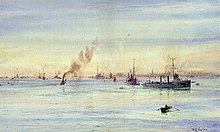Harwich Force
| Harwich Force | |
|---|---|
Battle off Noordhinder Bank | |
| Commanders | |
| Notable commanders | Reginald Tyrwhitt |
The Harwich Force originally called Harwich Striking Force was a squadron of the
It played a significant role in the war.History
After the outbreak of the First World War, it was important for the Royal Navy was to secure the approaches to the
Composition
The Harwich Force consisted of between four and eight light cruisers, several flotilla leaders and usually between 30 and 40 destroyers in
Rear-Admirals
Post holders included:
| Rank | Flag | Name | Term | Notes | |
|---|---|---|---|---|---|
| Rear-Admiral Commanding, Harwich Force | |||||
| 1 | Rear-Admiral | Reginald Tyrwhitt | 7 April 1914 – 1 May 1919[4] | receiving shore support from FOIC, Harwich | |
| 2 | Rear-Admiral | George Holmes Borrett | 1 March 1919[5] | ditto | |
| Rear-Admiral-in-Charge, Harwich | |||||
| 1 | Rear-Admiral | George Cuthbert Cayley |
2 July 1917 – 31 March 1918[6] | in charge of the base at Harwich Dockyard | |
| 2 | Rear-Admiral | Cecil Spencer Hickley | 1 April 1918 – 1 March 1919[7] | ditto | |
Service

It was intended that the Harwich Force would operate when possible in conjunction with the Dover Patrol, and the

The force was also active in a number of clashes with the Kaiserliche Marine (Imperial German Navy). Their ships were present at the Battles of Heligoland Bight, Texel, and Dogger Bank, and were mobilised after the German raids on Scarborough, Hartlepool and Whitby in 1914, and on Yarmouth and Lowestoft in 1916. They were called out during the prelude to the Battle of Jutland but did not take part in the battle.[8]
During the winter of 1916–1917, the force assisted the Dover Patrol in patrolling the Dover Barrage, an anti-submarine steel netting barrier which required on a large number of small vessels to operate and were vulnerable to attack by German destroyers and torpedo boats. Other regular patrols were mounted in The Downs, an anchorage in the eastern part of the Channel and another net barrage which was laid parallel to the Belgian coast. Forays along the coast of Germany sometimes resulted in the sinking or capture of German fishing vessels; on one sweep in 1915, twenty captured trawlers were brought to Harwich as prizes. Another duty was coastal bombardment of German positions in occupied Belgium; on one mission to bombard Ostend on 5 June 1917, Tyrwhitt's flagship, HMS Centaur, sank the German torpedo boat S.20 off Zeebrugge.[9]
After the end of the war, Harwich was designated the port at which the remaining German U-boats would be surrendered and Harwich Force oversaw the operation.[10]
Battle of Jutland
At the end of May 1916, at the time of the Battle of Jutland, the Harwich force consisted of:
- 5th Light Cruiser Squadron:
- Carysfort (Commodore Tyrwhitt)
- Cleopatra (Captain F. P. Loder-Symonds)
- Conquest (Captain Roger Backhouse)
- Canterbury (Captain Percy Royds, detached to Grand Fleet)
- Penelope (Captain Hubert Lynes; undergoing repairs)
- Vindex, a seaplane carrier (detached to Rosyth, Scotland)
- 9th Destroyer Flotilla
- light cruiser Undaunted (Capt. Francis G. St.John)
- destroyer leader Nimrod
- 17 (L-class) destroyers (Laforey, Lance, Lark, Lassoo, Laverock, Lawford, Leonidas, Lookout, Loyal, Lysander; detached to the Battlecruiser Fleet: Landrail, Laurel, Liberty, Lydiard; in repairs or refitting: Laertes, Lennox, Lucifer)
- 10th Destroyer Flotilla
The Harwich Force sortied to join the Grand Fleet on the initiative of Commodore Tyrwhitt early on 1 June 1916 in the hope that it might help should the action be re-joined later in the day but it was recalled by the Admiralty a few hours later and told to await orders. The following ships had sortied:[11]
- light cruisers: Carysfort, Cleopatra, Conquest, Aurora, Undaunted
- flotilla leaders Nimrod, Lightfoot
- destroyers:
- 1st Division: Laforey, Lookout, Lawford, Laverock
- 2nd Division: Lance, Lassoo, Lysander, Lark
- 3rd Division: Loyal, Leonidas, Mentor, Miranda
- 4th Division: Manly, Murray, Milne, Myngs
See also
Footnotes
- ^ Churchill 2005, p. 169.
- ^ a b c King-Hall 1929, pp. 11–12.
- ^ a b c Jellicoe 1920, pp. 127–129.
- ^ "Commodore 'T', Reginald Y Tyrwhitt, Rear-Admiral commanding Harwich Force, diary of events, 30 December 1917 to 19 April 1919". discovery.nationalarchives.gov.uk. The National Archives UK. Retrieved 5 February 2017.
- ^ Lovell, Tony; Harley, Simon (10 March 2018). "George Holmes Borrett". The Dreadnought Project. Retrieved 4 June 2018.
- ^ Lovell, Tony; Harley, Simon (28 August 2017). "George Cuthbert Cayley". The Dreadnought Project. Retrieved 15 February 2018.
- ^ Lovell, Tony; Harley, Simon (31 August 2017). "Cecil Spencer Hickley". The Dreadnought Project. Retrieved 4 June 2018.
- ^ a b Tucker 2005, p. 1,192.
- ^ Knight 2010, pp. 28–30.
- ^ Massie 2004, p. 780.
- ^ Admiralty 1920, pp. 341–342.
References
- Battle of Jutland, 30th May to 1st June 1916: Official Despatches with Appendices. Cmd. 1068 (online scan ed.). London: H.M. Stationery Office. 1920. OCLC 58965862– via Archive Foundation.
- Churchill, Winston (2005). The World Crisis, 1911–1918. New York: Simon and Schuster. ISBN 978-0-7432-8343-4.
- Jellicoe, Viscount Jellicoe Of Scapa (1920). The Crisis of the Naval War (online scan ed.). London: Cassell. OCLC 2920117– via Archive Foundation.
- King-Hall, Stephen (1929). The War on Sea: 1914–1918. Benn's Sixpenny library, no. 88. London: Ernest Benn. OCLC 977369458.
- Knight, E. F. (2010) [1919]. The Harwich Naval Forces. Project Gutenberg, 33769. Salt Lake City: Project Gutenberg. ISBN 978-1-4068-9601-5.
- ISBN 978-0-345-40878-5.
- Tucker, Spencer (2005). World War I: Encyclopedia. Santa Barbara, CA: ABC-CLIO. ISBN 1-85109-420-2.
Further reading
- Halpern, P. G. (1995) [1994]. A Naval History of World War I (pbk. UCL Press, London ed.). Annapolis: Naval Institute Press. ISBN 1-85728-498-4.
